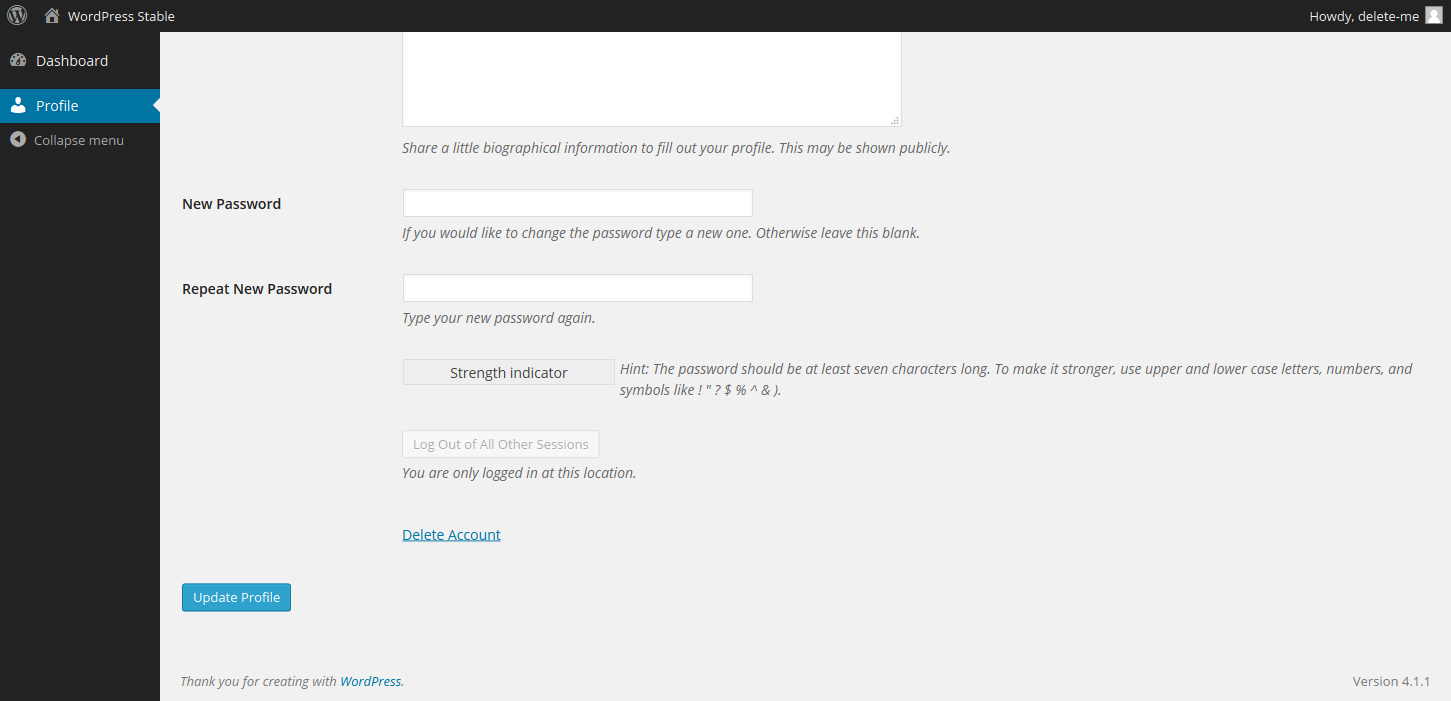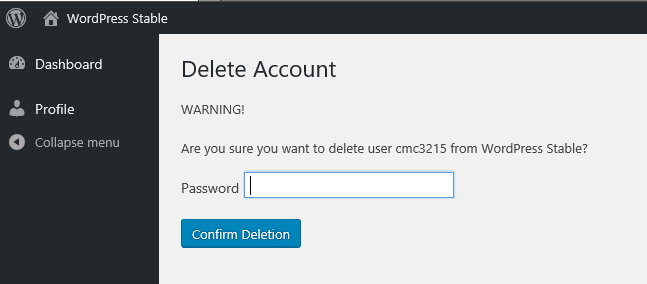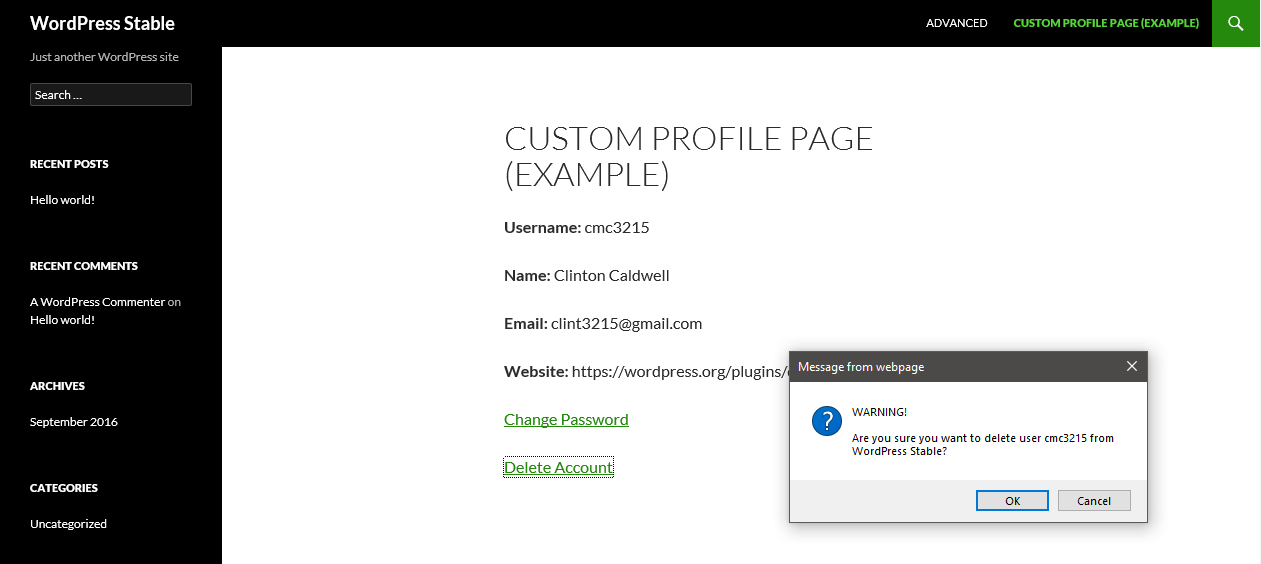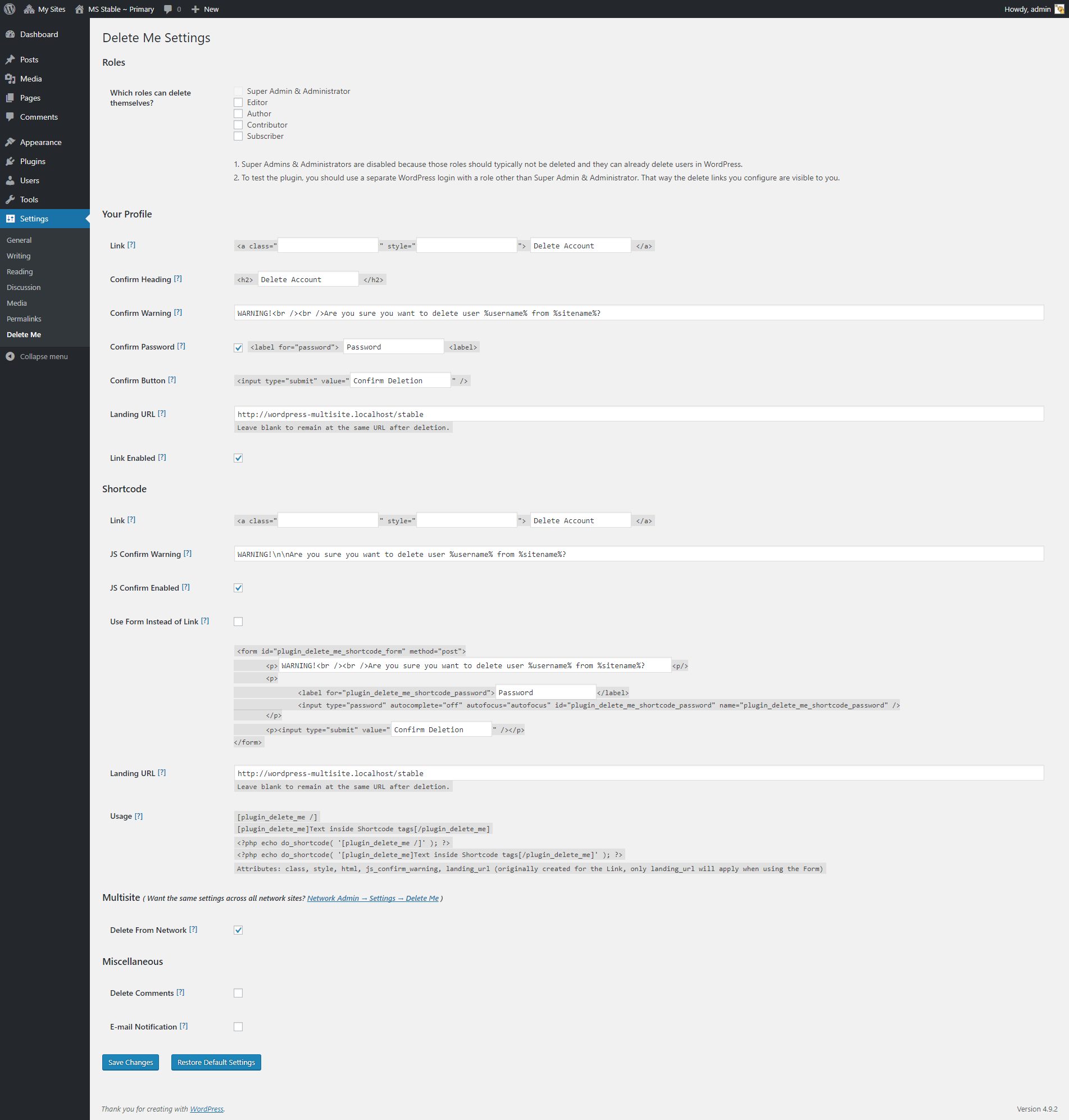Descripción
Permite a usuarios con perfiles WordPress específicos borrarse a sí mismos desde la página Tu perfil, o desde cualquier parte usando el shortcode [plugin_delete_me /].
Los ajustes de este plugin están en el subpanel Ajustes -> Delete Me. Compatible con multisitio y activación para la red.
Cómo funciona:
-
Un usuario hace clic en el enlace de borrar, que por defecto implica «Borrar la cuenta», pero puede cambiarse.
-
Se le pide al usuario que confirme que quiere borrarse a sí mismo.
-
Si se confirma, el usuario y todas sus entradas, enlaces y (opcionalmente) comentarios se borran.
-
La redirección del usuario borrado (opcional) a la URL de la página de aterrizaje, por defecto a portada, puede cambiarse o dejarse en blanco.
Ajustes disponibles:
-
Activa o desactiva para toda la red, lo que se aplica a una sola página de ajustes en todos los sitios de una red multisitio.
-
Elige perfiles WordPress específicos (p.ej: suscriptor) a los que quiera permitir que se borren a sí mismos usando Delete Me.
-
Atributos
claseyestilodel enlace de borrar. -
Contenido clicable de la etiqueta
<a>del enlace de borrar. -
URL de la página de aterrizaje.
-
Encabezado de la página de confirmación de Tu perfil, Advertencia, Contraseña (puede requerir contraseña opcionalmente), Botón.
-
Activa o desactiva el enlace de borrar en la página Tu perfil.
-
Texto de confirmación por Javascript para el shortcode.
-
Activa o desactiva la confirmación por Javascript desde el shortcode.
-
Activar o desactivar usando un formulario (requiere contraseña) en vez de un shortcode de enlace.
-
Multisitio: Borrar el usuario de la red entera o solo en el sitio actual.
-
Borrar comentarios.
-
Aviso por correo electrónico cuando un usuario se borra a sí mismo.
Capturas

Página Tu perfil. 
Página de confirmación en Tu perfil. (Esta página viene incluida) 
Ejemplo de shortcode de enlace. (activa o desactiva el diálogo de confirmación por Javascript) 
Ejemplo de shortcode de formulario. (crea una página como esta y envía a los usuarios ahí para que confirmen el borrado) 
Subpanel Administrador de la red -> Ajusutes -> Delete Me. (solo en instalaciones multisitio) 
Subpanel Ajustes -> Delete Me.
Instalación
Básico
-
Instálalo automáticamente en WordPress en el subpanel Plugins -> Añadir nuevo o sube la carpeta delete-me al directorio /wp-content/plugins/.
-
Activa el plugin en el panel Plugins de WordPress.
-
Ve al subpanel Ajustes -> Delete Me, selecciona los perfiles WordPress a los que quieras permitir que se borren a sí mismos usando Delete Me y haz clic en Guardar cambios.
-
¡Exacto! El enlace de borrar se situará automáticamente junto al botón de la página Tu perfil en los perfiles que actives. Si prefieres que el enlace de borrar esté en tu web, por favor, lee más abajo.
Avanzado: Uso del shortcode
Nota: Para evitar que el enlace de borrar aparezca en la página Tu perfil, desmarca el ajuste Enlace activado.
- Página de perfil personalizada – Copia y pega el shortcode
[plugin_delete_me /]en la entrada o página que hayas creado. - Archivo del tema – Para llamar al shortcode en uno de los archivos .php de tu tema utiliza
<?php echo do_shortcode( '[plugin_delete_me /]' ); ?>. - Widget de texto – Para usar el shortcode en un widget de texto asegúrate de que la línea
add_filter( 'widget_text', 'do_shortcode' );está en el archivo de funciones (functions.php) de tu tema. - Atributos – Los atributos
class, style, html, js_confirm_warning, landing_urlse pueden usar para omitir ajustes, pero no son obligatorios. Ofrecen a los propietarios de sitios usar varios idiomas y/o enlaces en el mismo sitio o incluso en la misma página si se configura de otro modo.
Advanced: Translation
Note: Languages directory for plugins: /wp-content/languages/plugins
- Choose a translation method:
A) Get or provide translations of this plugin on WordPress.org. Alternatively, some language plugins (e.g. Polylang) can download and install the publicly available language files for plugins.
B) Create your own translations using the included delete-me.pot template file found in this plugin’s languages directory and the free tool Poedit. - Once you have finished your translations, export and save them as a .mo file.
- Name the .mo file delete-me-{locale}.mo (e.g. delete-me-en_US.mo)
- Place the .mo file into the languages directory for plugins.
If you’re using Poedit, it will create a .po file too. You should keep the .po file in order to open and save changes to your translations or to update the .po file with source text changes when an updated delete-me.pot file is released. Just be aware that the actual translations used by the plugin are inside the .mo file.
Warning: If you place your translation files into this plugin’s languages directory instead of the directory shown above, they will be deleted or replaced with any the author might include when updating the plugin.
FAQ
-
¿Qué pasa con las entradas, enlaces y (ocasionalmente) los comentarios que pertenezcan un usuario borrado?
-
La mayoría de los tipos de contenido y comentarios se mueven a la papelera. Los enlaces siempre se borran permanentemente.
-
¿Es este plugin compatible con WordPress multisitio?
-
Sí, es compatible con activar para toda la red y para un solo sitio. Los usuarios y su contenido solo se borrarán del sitio del que ellos mismos se borren, el resto de sitios de la red no se ven afectados.
-
Al usar multisitio ¿se borran los usuarios de la red o solo del sitio del que se originó el borrado?
-
By default, users registered to multiple Sites on the Network are only deleted from the current Site and will remain registered to their remaining Sites. However, if the setting «Delete From Network» is checked, users will be deleted from the entire Network.
-
¿Es posible que un usuario borre a alguien que no sea él mismo?
-
No, el usuario borrado es el usuario conectado en este momento.
-
¿Que muestra el shortcode cuando los usuarios no están conectados o su perfil no tiene permisos para borrarse a sí mismos?
-
Nada, cuando usas la etiqueta de cierre automático del shortcode (p.ej.
[plugin_delete_me /]). No obstante, cuando se usan las etiquetas de shortcode de apertura y cierre (p.ej.[plugin_delete_me]Contenido[/plugin_delete_me]), el contenido dentro de las etiquetas aparecerá en vez del enlace de borrar. -
¿A dónde se envía a los usuarios después de que se borren a sí mismos?
-
El subpanel Ajustes -> Delete Me te permite introducir cualquier URL a la que quieras redirigir a los usuarios borrados, y está configurado por defecto a la portada. Puedes dejar en blanco «URL de aterrizaje» para que los usuarios se queden en la misma URL tras el borrado.
-
¿Hay alguna confirmación antes de que los usuarios se borren a sí mismos?
-
Sí, el enlace de borrar en la página Tu perfil lleva a una página de confirmación pre-configurada. Opcionalmente puedes requerir a los usuarios que confirmen su contraseña en esta página antes del borrado. El shortcode de enlace de borrado ofrece un diálogo de confirmación por Javascript [Aceptar] [Cancelar] por defecto, pero puede desactivarse si se quiere. Adicionalmente, el shortcode tiene una opción para ofrecer un formulario en vez del enlace, que requiere a los usuarios confirmar su contraseña.
-
¿Puedo recibir aviso de los usuarios que se borran a sí mismos y de qué se ha borrado?
-
Sí. El subpanel Ajustes -> Delete Me tiene un ajuste llamado «Aviso por correo electrónico», simplemente marca la casilla y guarda los cambios.
-
¿Este plugin guarda alguna información personal sobre los usuarios?
-
No, the only data stored is related to the plugin’s settings which are located on the Settings -> Delete Me subpanel.
Reseñas
Colaboradores y desarrolladores
«Delete Me» es un software de código abierto. Las siguientes personas han colaborado con este plugin.
Colaboradores«Delete Me» está traducido en 4 idiomas. Gracias a los traductores por sus contribuciones.
Traduce «Delete Me» a tu idioma.
¿Interesado en el desarrollo?
Revisa el código , echa un vistazo al repositorio SVN o suscríbete al registro de desarrollo por RSS.
Registro de cambios
3.1
- Release date: 11/11/2023
- Added output sanitization to all editable settings to remove cross-site scripting vulnerability.
3.0
- Fecha de lanzamiento: 05/09/2020
- Added 3 new attributes for the shortcode form: form_confirm_warning, form_password_label, form_confirm_button
- Added %displayname% replacement string everywhere that %username% was already available.
2.9
- Release date: 04/05/2020
- Added paragraph tag around shortcode output to prevent alignment issues.
2.8
- Release date: 12/19/2018
- Added Role, First Name, and Last Name user data to email notification.
2.7
- Release date: 07/29/2018
- Bug fixed: Using a blank landing URL would cause a failure during redirect on some server configurations.
- Bug fixed: Landing URLs on the Settings page were incorrectly having http:// added to them when they did not contain a URL scheme.
2.6
- Release date: 05/25/2018
- Fixed 2 PHP parse errors affecting those using a PHP version less than 5.4.
- Added message for Administrators, in place of delete link (or form), to remind them the delete option configured is not visible to Administrators.
2.5
- Release date: 03/01/2018
- Multisite setting «Delete From Network» has been changed to be more intuitive. Users are now deleted from the entire Network regardless of the number of Sites to which they belong.
- Multisite setting «Delete From Network» is now unchecked by default.
- Multisite e-mail notifications now include the total number (if more than one) of Network Sites from which a user has been deleted whenever «Delete From Network» is checked.
2.4
- Release date: 02/16/2018
- Bug fixed: Added missing text domain to two translations.
- Removed invalid Plugin URI to comply with WordPress plugin Header Requirements
2.3
- Release date: 02/06/2018
- Added support for translation; a languages folder now contains a .POT file containing the English strings for translation.
- Removed wpml-config.xml to prevent conflicts and confusion between the database option and the newly added standard translation calls.
- Replaced donation link on Plugins page with link to Changelog.
- From this version forward, downgrading the plugin to a previous version will work but automatically resets settings to defaults.
- WordPress minimum required version changed from 3.4 to 3.7.
2.2
- Release date: 01/27/2018
- Bug fixed: Multisite installations with Network Wide enabled would not get selected role updates for roles of newly added Sites.
- Bug fixed: Error on user delete for WordPress versions less than 4.4.
2.1
- Release date: 01/26/2018
- Added Network Wide settings for Multisite installations that apply a single page of settings across all network Sites.
- Added a setting that requires users to confirm their password on the Your Profile confirmation page.
- Added a setting that allows inserting a form when using the shortcode instead of a link. This setting will also require users to confirm their password before deletion.
- Added «user_registered» (e.g. 2018-01-25 01:30:15) user data to the deleted user email notification.
- Ahora se puede usar %sitename% como reemplazo de texto en los mensajes de advertencia. También se han actualizado los mensajes de advertencia por defecto para incluir su uso.
2.0
- Release date: 06/22/2016
- Applied init change discussed at https://wpml.org/forums/topic/delet-me-cant-be-translated/#post-919867
- Added wpml-config.xml file to allow easier use with the popular WPML plugin.
1.9
- Release date: 12/08/2015
- Fixed issue with using Shortcode multiple times on the same page or post.
1.8
- Release date: 07/15/2015
- The following new Shortcode attributes may be used to override settings, but are not required: class, style, html, js_confirm_warning, landing_url.
- v1.7 change reverted – %shortcode% term no longer used, attributes were added instead for a more complete and consistent way of customizing the shortcode.
1.7
- Release date: 07/14/2015
- Shortcode Link text can now contain %shortcode% which is replaced with the text inside the open and close shortcode tags. This was added to allow a dynamic way of changing the delete link text.
1.6
- Release date: 03/09/2015
- Your Profile delete link now leads to a customizable confirmation page instead of the Javascript confirm dialog.
- Added settings for Your Profile confirmation page Heading, Warning, and Button.
- Added setting to enable or disable Javascript confirm dialog for Shortcode delete link. This was added to make it easier to use a custom confirmation page with the Shortcode.
1.5
- Release date: 10/18/2014
- Your Profile and Shortcode «Landing URL» may now be left blank to remain at the same URL after deletion.
- Removed setting and code for «Uninstall on Deactivate». You can still wipe all traces of the plugin from the Plugins panel by deactivating and clicking Delete.
- Added button on settings page, «Restore Default Settings».
- Shortcode deletion link no longer relies on the get_permalink() function. This makes the shortcode’s placement more flexible and the link location more accurate.
- wp_logout() function is now run after user deletion to cleanup session and auth cookies.
- Delete link default updated, old = «Delete Profile», new = «Delete Account».
- Javascript confirm text default updated, the line about Post and Links was removed.
1.4
- Release date: 04/24/2013
- Added setting to enable or disable the delete link on the Your Profile page.
- Added an uninstall.php file. This enables removal of the plugin capabilities and settings when you «Delete» the plugin from the
Pluginspanel in WordPress. - Fixed possible PHP Warning: missing argument 2
$wpdb->prepare()on Multisite installations using WordPress 3.5+ - Fixed possible PHP Fatal error: undefined function
is_plugin_active_for_network()on Multisite installations when adding a new Site from outside the WordPress Admin pages. - Consolidated scripts to reduce the number of files used and the total plugin filesize.
1.3
- Release date: 04/23/2013
- Added setting to customize Javascript confirm text.
1.2
- Release date: 02/07/2013
- WordPress 3.4 now required.
- Added Multisite and Network Activation support.
- Added setting for Multisite to delete user from Network if user no longer belongs to any Network Sites.
- Added setting to delete comments.
- Edited e-mail notification to list the number of comments deleted.
1.1
- Release date: 04/11/2011
- Added setting for detailed e-mail notification when a user deletes themselves.
- Fixed undefined function errors for wp_delete_post and wp_delete_link when user has Posts or Links.
1.0
- Release date: 04/09/2011
- Versión inicial.